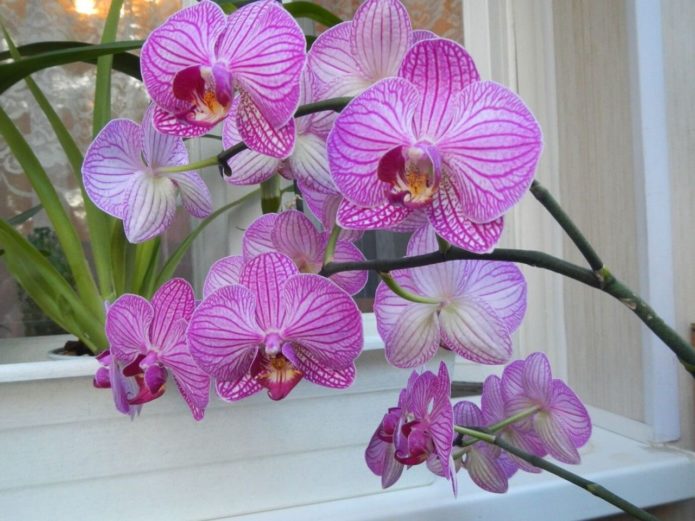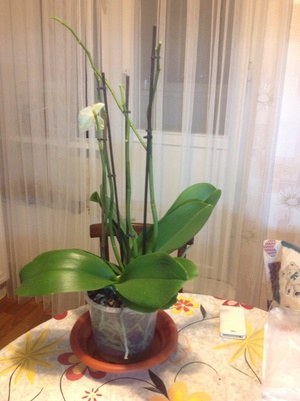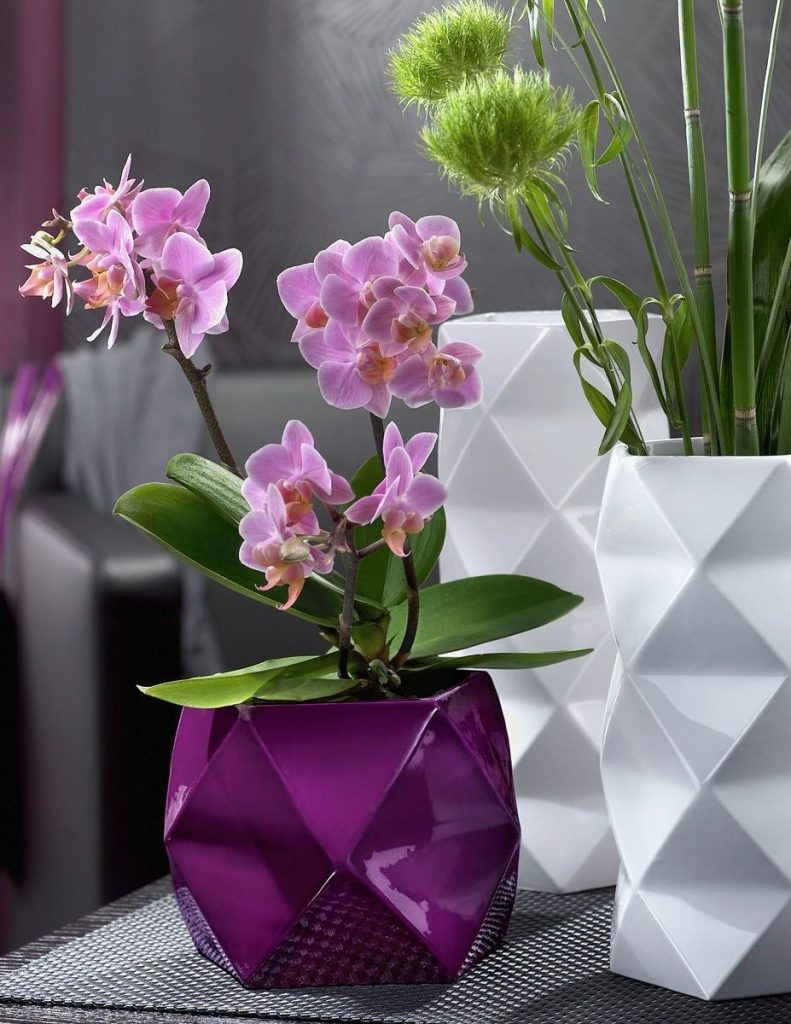Orchids are among the most beautiful and mysterious flowers. Now more than 30 thousand species of these amazing plants have been discovered. They are distributed from the tropics to the Arctic Circle. There are few orchid species growing naturally in our latitudes, but they are. For example, the lady's slipper orchid. And there is a huge amount of artificially created varieties and forms in general.
And if earlier growing orchids at home was the occupation of only a few experienced enthusiasts, now the orchid can be found in many apartments and houses. This happened thanks to the withdrawal relatively unpretentious hybrids and mass production of planting material in various flower farms.
But shops, to increase sales, display orchids at the most colorful, but the most inopportune moment. The fact is that flowering is a rather difficult moment for a plant and they tolerate a sharp change in conditions even worse. After all, they are grown for sale in greenhouses, in almost ideal conditions for them. And the conditions of the outlet, where the plants are located before the sale, and in most apartments, are far from ideal. In addition, sellers often do not have the qualifications sufficient to competently consult the future owner of this beautiful flower.
Therefore, a novice grower has a lot of questions: how to care for a plant, how to prolong flowering, the orchid has faded - what to do with the arrow and so on. We will try to answer them in this article.
These recommendations refer mainly to the most common phalaenopsis orchid in our apartments. But can also be applied to most cultivated species. But it should be borne in mind that some types of orchids put forward specific requirements for care. This, for the most part, depends on the origin, on the conditions of their natural habitat.
Content
Orchid bloom
The flowering period of orchids is perhaps the most desirable result of growing these plants, with the exception of the species grown for ornamental leaves.
 Flowering duration depends on many factors: on the species, variety, condition of a particular specimen, growing conditions, etc. Some orchids bloom for 3-4 days, which is normal for them, while others continue the flowering period for more than 3 months.
Flowering duration depends on many factors: on the species, variety, condition of a particular specimen, growing conditions, etc. Some orchids bloom for 3-4 days, which is normal for them, while others continue the flowering period for more than 3 months.
Despite the fact that the flower has gained the fame of a difficult and capricious plant, many amateurs successfully grow orchids at home. But sometimes they are faced with such a situation that the flower does not go on to flowering, despite all the efforts made. To be successful, you need to adhere to the rules of daily care.
It should also be borne in mind that orchid are perennial plantstherefore flowering should begin at a certain age. When purchasing an orchid, it is required to clarify with the distributor the age of the seedling and the time of the beginning of the flowering period for this particular species. If the plant is too young, and it has already formed buds, it is better to refuse to purchase this specimen.Because if flowering begins prematurely, the plant can be exhausted and die even before the end of such a difficult stage of life.
Care rules for stable flowering
Phalaenopsis, like the rest of the orchids, requires certain conditions in order to delight us with regular and lush flowering. Their care requirements are higher than those of ordinary indoor flowers. But create an optimal environment for the growth of orchids also will not be difficult.
Consider the main points of care.
Lighting
 Lighting plays a significant role in orchid growing. These flowers require diffused but intense light. Since most of them have adapted to life in the forests, in some shade. Direct rays of the sun can burn them, and lack of light leads to a slowdown in growth and, as a result, the cessation of flowering.
Lighting plays a significant role in orchid growing. These flowers require diffused but intense light. Since most of them have adapted to life in the forests, in some shade. Direct rays of the sun can burn them, and lack of light leads to a slowdown in growth and, as a result, the cessation of flowering.
It is especially difficult for plants in winter, when daylight hours decrease, there is very little natural light.
Solve this problem with:
- Fluorescent lamps.
- Sodium lamps.
- LED luminaires, so-called phytolamp.
Most common fluorescent and sodium lamps... They create a spectrum of light that is closest to natural. But the best option would be, albeit still quite expensive, the so-called. phytolamps. They are a set of LED diodes that create a luminous flux of the spectral composition necessary for plants. However, they emit little heat (reduces the risk of "burning" the plants), are durable and economical. Conventional incandescent lamps are absolutely unsuitable for supplemental lighting, since they convert 90-95 percent of the energy into infrared radiation, that is, they simply work as a "heater" and not as a light source.
Air surrounding the plant
As mentioned earlier, most orchids and phalaenopsis in particular are home to rainforest... Hence the increased requirements for air humidity. Phalaenopsis needs about 80% humidity. But in apartments, especially with central heating, the humidity is much lower. Therefore, additional moisture is required.
To increase the humidity of the air near the plant, you can limit the space from the rest of the room with ordinary film, periodic treatments with water from a spray bottle. If there is not enough time for this, you can install wide open containers with water, in the immediate vicinity of the flowers. But, direct contact of the roots with water should be avoided - this can lead to their rotting.
Watering
 Despite the fact that orchids are quite hygrophilous, excess moisture should be avoided... These inevitably lead to disease and general weakening of the plant. During the dormant period, flowers are watered, in general, rarely, only to prevent the earth from drying out.
Despite the fact that orchids are quite hygrophilous, excess moisture should be avoided... These inevitably lead to disease and general weakening of the plant. During the dormant period, flowers are watered, in general, rarely, only to prevent the earth from drying out.
Also, do not forget to monitor the condition of the drainage holes. After watering, the water should drain freely from the pot. It is absolutely impossible to allow it to stagnate.
Watering can be carried out both directly to the roots of plants, and immersing the whole pot in water, for 10-15 minutes. So the moisture evenly permeates the entire soil.
Fertilizers
For a novice florist, it would be best to use ready-made complex fertilizers for orchids, which are presented in a wide range in specialized stores. But, it is necessary to strictly follow the instructions that are indicated on the preparations.
Orchid preparations can be divided into specific groups:
- Satisfying the need of a plant in any one element - nitrogen, phosphorus, potassium.
- Complex fertilizers. They contain all the necessary set of elements for plant nutrition.
- Various growth stimulants. They stimulate growth, root formation, are used in conjunction with fertilizers.
Create artificial stress
The natural conditions for the growth of orchids are heterogeneous, so these plants have developed certain mechanisms of reaction to unfavorable conditions.
This is what the "artificial stress" method is based on. To do this, if possible, lower the temperature by 4-5 degrees, reduce watering as much as possible, preventing the soil from drying out in the pot, exclude top dressing. This procedure is carried out within 1.5-2 months. When conditions return to normal, this serves as a signal to the plant that the unfavorable period is over and stimulates flowering.
The orchid has faded, what to do with the arrow?
The most colorful period of the life of orchids is over. The first question that arises for beginners - phalaenopsis has faded, what to do next? What care is needed after the orchid bloom period?
First, you need to make sure that the plant has really bloomed. To do this, you must carefully examine the tip of the peduncle and its lateral branches. If they are green and intact, then there is a possibility that the flowering is not yet complete, and additional buds may form... This can happen either during the main flowering period or several weeks after most flowers have fallen off.
 If the tip has dried out, changed color, becoming yellow, most likely, you do not need to expect new buds. What should be done in this case? You can cut the peduncle above the last, the so-called "sleeping point". Pruning is carried out just above the buds, at a distance of about 1.5 cm. Many orchid species form several "dormant" buds (scientific name, meristems), which are covered with protective scales. These buds, as the plant develops, can be activated and grow, forming a lateral peduncle.
If the tip has dried out, changed color, becoming yellow, most likely, you do not need to expect new buds. What should be done in this case? You can cut the peduncle above the last, the so-called "sleeping point". Pruning is carried out just above the buds, at a distance of about 1.5 cm. Many orchid species form several "dormant" buds (scientific name, meristems), which are covered with protective scales. These buds, as the plant develops, can be activated and grow, forming a lateral peduncle.
After making sure that the orchid has faded, you can, if necessary, proceed to another important point of care - a transplant. Since it is impossible to transplant during flowering.
Orchid transplant process can be divided into certain main stages:
- Preparing the soil and a new container for the plant.
- Directly transplanting and preventive measures with the root system.
- Providing optimal conditions for plant adaptation after transplantation.
New soil for this is better for beginners to buy ready-made, in a specialized store. Before transplanting, it is necessary to thoroughly wet the soil in the pot so that the plant is easier to reach and the roots are not damaged.
Taking a plant out of an old pot, examine the root system carefully... It is necessary to cut off any dried, damaged or diseased roots with a sharp tool. Healthy are distinguished by light color and elasticity.
When replanting a plant, you need to be especially careful with the roots. The plant must be immersed to the same level as in the old container. Watering immediately after transplanting is optional, the best is to spray thoroughly and leave it in a damp, shaded place for a couple of weeks.
Further care for the orchid after flowering does not particularly differ from the usual one, you just need to observe the watering and feeding regime.
Dormant period in orchids
 In most orchid species, after the flowering period there is a period of relative rest, during which the growth rate is greatly reduced, the metabolic rate slows down. The period of dormancy itself, its duration or absence depend on the climatic conditions in the homeland of a particular plant.
In most orchid species, after the flowering period there is a period of relative rest, during which the growth rate is greatly reduced, the metabolic rate slows down. The period of dormancy itself, its duration or absence depend on the climatic conditions in the homeland of a particular plant.
After the completion of the growth of young shoots, most orchids enter a period of relative dormancy. It is at this moment that the plant needs to lower the temperature and reduce the number of watering. Such conditions promote the formation of flower buds, which, subject to the correct care regimen, will form flowers.
There are species of orchids with a full dormant period (for example, Pleione). This is expressed in the fact that the aboveground part of the plant dies off, only the roots remain, all metabolic processes are inhibited as much as possible for several months. In addition, nothing is required to be done, at the end of the dormant period, the roots themselves give new shoots.
There are also species in which the dormant period is not so pronounced or absent. Such plants grow actively throughout the year (for example, Phalaenopsis).
Conclusion
"When the orchid has faded, what to do?" - after reading this article, you will no longer ask yourself such a question.
Post-orchid care is not as difficult as it might seem. Follow easy tips, mentioned above and orchids will delight with their health and beauty for more than one year.



